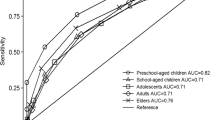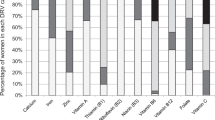Abstract
The aim of the survey was to record the food habits and nutrient intake of Greek children. Data was obtained by a 3 d household measured diet record from a random stratified sample (1936 children aged 2–14 y). Mean daily protein intake was much higher than PRI and none of the children had lower intake than AR. Mean energy intake from protein was 15%, carbohydrate 44% and fat 41%. Eighty-four percent of children had energy intake from fat higher than the AR. Saturated fatty acids (SFA) provided approximately 15%, monounsaturated (MUFA) 17% and polyunsaturated (PUFA) 6% of energy. Eighty-seven percent of children had higher intake of SFA than the AR. Six percent of children had SFA intake lower than the AR and 50% higher than the AR. None of the children had PUFA intake lower than PRI and 0.3% higher than the maximum limit. 4.2% of children had calcium intake lower than LTI and 88% higher or equal to PRI. All children had phosphorus intake higher than PRI and less than the lower safe ratio of Ca/P; 50% of them had P intake higher than 1.5 g/d. The majority of children had sufficient iron intake with the exception of menstruated girls. Mean vitamin A intake was higher than PRI and lower than the toxic levels. All children had vitamin C intake higher than LTI. Median vitamin D intake varied from 1.7–2.1 μµgr. Median energy intake was higher than the AR in preschool children, but lower in the older children. We conclude that Greek children do not underintake energy and protein, overintake SFA, have safe intake of PUFA, vitamin A and C and high intake of MUFA, underintake carbohydrates, have adequate Ca, but a considerably high P intake. Vitamin D is low in small children, but the biological available vitamin D is obviously higher due to sunlight.
This is a preview of subscription content, access via your institution
Access options
Subscribe to this journal
Receive 12 print issues and online access
$259.00 per year
only $21.58 per issue
Buy this article
- Purchase on Springer Link
- Instant access to full article PDF
Prices may be subject to local taxes which are calculated during checkout
Similar content being viewed by others
Author information
Authors and Affiliations
Rights and permissions
About this article
Cite this article
Roma-Giannikou, E., Adamidis, D., Gianniou, M. et al. Nutritional survey in Greek children: nutrient intake. Eur J Clin Nutr 51, 273–285 (1997). https://doi.org/10.1038/sj.ejcn.1600388
Received:
Revised:
Accepted:
Issue Date:
DOI: https://doi.org/10.1038/sj.ejcn.1600388
Keywords
This article is cited by
-
Prevalence and geographic variation of abdominal obesity in 7- and 9-year-old children in Greece; World Health Organization Childhood Obesity Surveillance Initiative 2010
BMC Public Health (2017)
-
Higher levels of s-RANKL and osteoprotegerin in children and adolescents with type 1 diabetes mellitus may indicate increased osteoclast signaling and predisposition to lower bone mass: a multivariate cross-sectional analysis
Osteoporosis International (2016)
-
The role and requirements of digestible dietary carbohydrates in infants and toddlers
European Journal of Clinical Nutrition (2012)
-
Dietary Habits of Greek Primary School Children
Journal of Science Education and Technology (2007)
-
Design and descriptive results of the "Growth, Exercise and Nutrition Epidemiological Study In preSchoolers": The GENESIS Study
BMC Public Health (2006)



